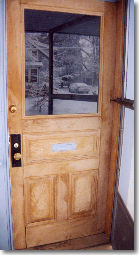 |
 |
 |
 |
 |
 |
(Courtesy of the Massachusetts Childhood Lead Poisoning Prevention Program)
What is lead poisoning?
Lead poisoning is a disease caused by ingesting or inhaling lead. It can damage the brain, kidneys, and nervous system of young children. Low levels can cause learning and behavioral problems. Very high levels can cause retardation, convulsions, and coma.How do children become lead poisoned?
Children are most often poisoned by lead dust and lead paint in older homes. Lead dust can come from repairing areas with lead paint, opening and closing windows, and through normal wear and tear of painted areas. Lead dust settles to the floor and gets on children's hands and toys. It enters their bodies when they put their hands or toys into their mouths.Children can also become lead poisoned by eating, chewing, or sucking on things with lead paint such as windowsills, railings, or other painted surfaces.
Repairs and renovations of older homes increase the risk of lead poisoning. Children and pregnant women should not be in the home when this work is being done.
What makes some children at higher risk for lead poisoning?
Children are at higher risk if they live in homes built before 1978. Children will absorb more lead into their systems if their diets are low in calcium and iron, and high in fat. Also, if parents work with lead, they may bring lead dust home on their clothes or hair.How will I know if my child has lead poisoning?
Most children do not have any symptoms. Your child can have lead poisoning and not appear or act sick. Some children may feel very tired, have no appetite, or have headaches and stomach aches. A blood test is the only way to tell if your child has lead poisoning.Who should be tested for lead and how often?
Every child in Massachusetts under the age of four must be tested for lead each year. Some children should be tested more often if they are at higher risk. Ask your health care provider how often your child should be tested.What is a lead test?
A small amount of blood is taken from your child's finger or arm and tested for lead. If the test result is high, another test may be done. Ask your doctor, local lead program, or health center to test your child for lead.What if my child has lead poisoning?
Your health care provider will talk to you about lead poisoning and test your child again. Your child may be given iron or medicines which remove lead.An inspector will test your home for lead paint. If lead paint is found, the homeowner must have it removed or covered. Also, a nurse or a family counselor may visit you.
What are the sources of lead in our environment?
The most common sources of lead are the dust created during repairs and renovations to older homes, and lead chips and dust from lead painted areas.
- Painted window wells and sills
- Painted door frames
- Painted walls and floors
- Painted woodwork
- Painted stairs and railings
- Painted porches
- Old painted toys, cribs, and furniture
- Painted radiators and pipes
- Painted house exteriors
- Water from lead pipes and solder
- Food grown in soil with lead
- Food stored in lead glazed pottery
- Soil near old lead painted buildings (especially if they have been scraped, sandblasted, or have peeling paint.)
- Soil near busy roads
{Alpine Environmental, Inc.} {Client List} {E-Mail Us} {Home}
ALPINE
ENVIRONMENTAL, INC.
21 Progress Ave., Suite #1, Chelmsford, MA 01824
Phone: 978-250-2740 Fax: 978-250-0565
E-Mail: [email protected]
